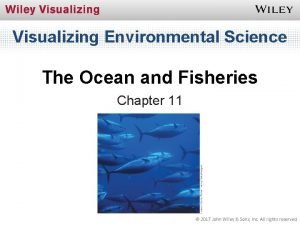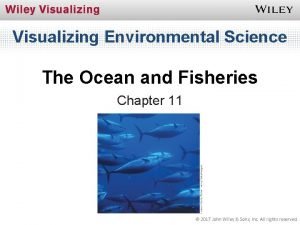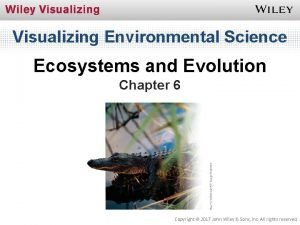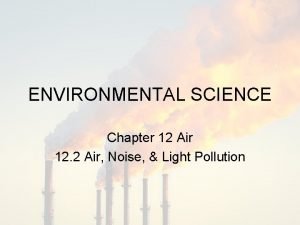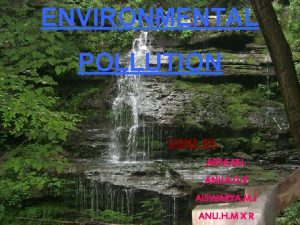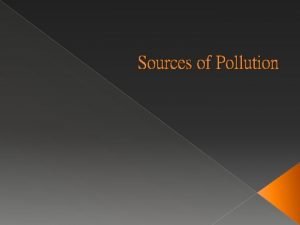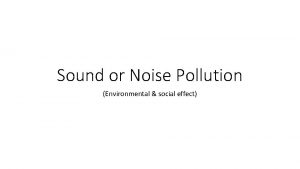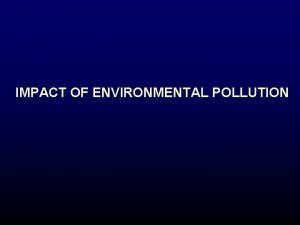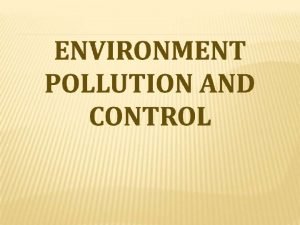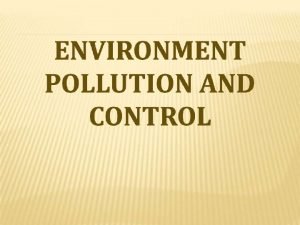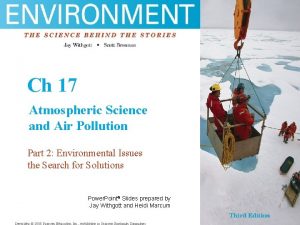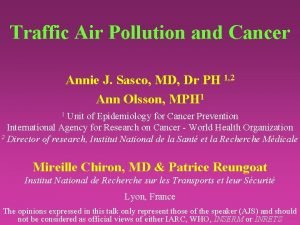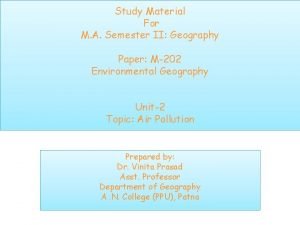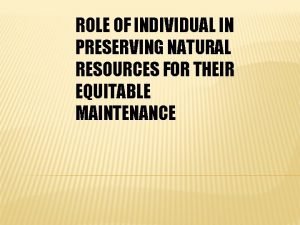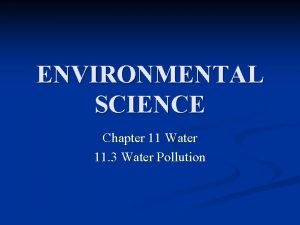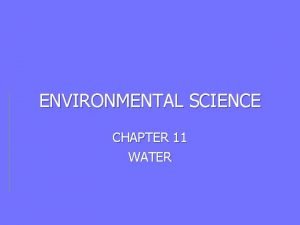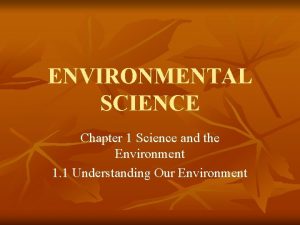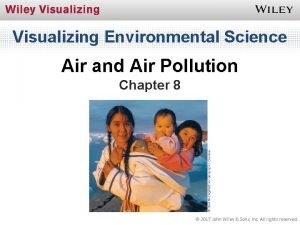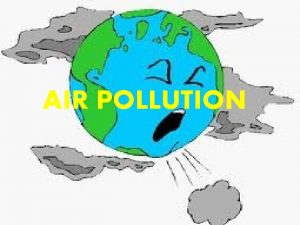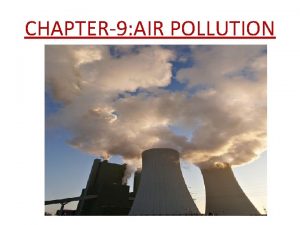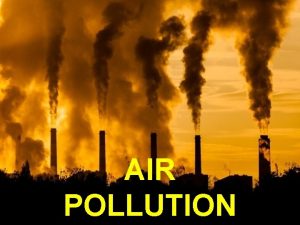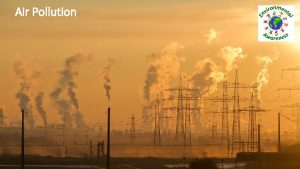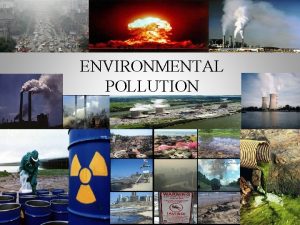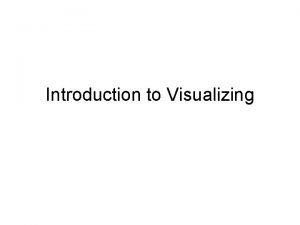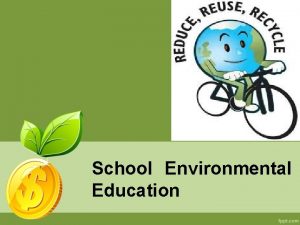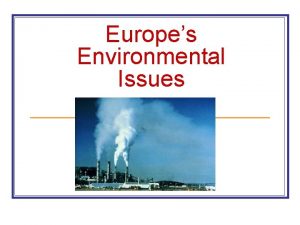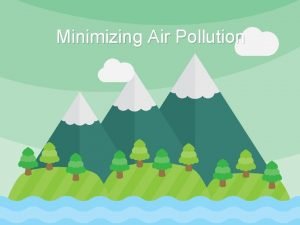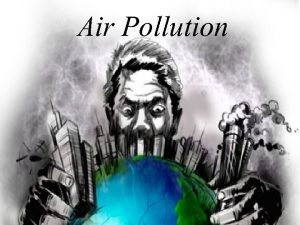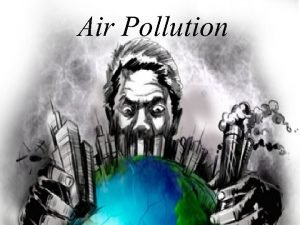Visualizing Environmental Science Air and Air Pollution Chapter




















- Slides: 20

Visualizing Environmental Science Air and Air Pollution Chapter 8 © 2017 John Wiley & Sons, Inc. All rights reserved.

The Atmosphere • Atmosphere – Gaseous envelope surrounding Earth • Composed of: 78% ________ 21% oxygen 0. 04% ____________ 0. 93% argon 0. 03% other gases Water vapor and trace amounts of air pollutants • The atmosphere becomes less _____ as it extends outward into space – – – © 2017 John Wiley & Sons, Inc. All rights reserved.

The Atmosphere • The atmosphere is composed of four concentric layers – Troposphere – __________ – Mesosphere – Thermosphere • These layers vary in ________ and temperature, depending on latitude and season © 2017 John Wiley & Sons, Inc. All rights reserved.

The Atmosphere • The atmosphere performs several ecosystem services – Protects Earth from most radiation from the sun and space • ____________ • X-rays • Cosmic rays — Without this atmospheric radiation shield, life as we know it would cease to exist – Naturally occurring _____________ absorb some reradiated heat • Keeps surface temperature within habitable range for life to exist – Atmosphere is modified and partially maintained by living organisms • Photosynthesis contributes _____, cellular respiration ______

Atmospheric Circulation • Variation in solar energy reaching the earth creates temperature differences that drive atmospheric ________ • In atmospheric _________, solar heating of the ground causes the air to warm, producing an updraft of this less dense, warm air • The convection process ultimately causes air _______, which mix warmer with cooler parts of the atmosphere © 2017 John Wiley & Sons, Inc. All rights reserved.

Atmospheric Circulation • Atmospheric circulation transports heat from the equator to the _____ • Greatest solar energy input is at the ________ • Air travels towards the _____, cools and descends at 30 degrees latitude • At higher latitudes, pattern of air circulation is complex © 2017 John Wiley & Sons, Inc. All rights reserved.

Atmospheric Circulation • ______ – Smaller scale horizontal atmosphere movements that result from changes in atmospheric pressure and the planet’s rotation • There are _______ prevailing winds that blow continually – Polar easterlies: Winds near the _____ – __________: Middle latitude winds – Trade winds: Tropical winds The _________ effect: Winds and ocean currents are deflected to the right in the Northern Hemisphere and to the left in the Southern Hemisphere

Types and Sources of Air Pollution • Air pollution – Various ________ (gases, liquids, solids) present in the atmosphere in harmful levels – Can be from natural sources (smoke from forest fires; volcanic emissions), or anthropogenic (__________ or industrial byproducts, amongst others) • Two main categories of air pollutants – _________ air pollutants • Harmful chemicals that are released directly from a source into the atmosphere – Secondary air pollutants • Chemicals that form in the atmosphere when primary air pollutants _____ chemically with one another or with natural components of the atmosphere © 2017 John Wiley & Sons, Inc. All rights reserved.

Types and Sources of Air Pollution • Air pollution – Primary air pollutants: • Carbon oxides • Nitrogen oxides • __________ • Particulate matter • Hydrocarbons – Secondary air pollutants: • ______ • Sulfur trioxide • Some acids © 2017 John Wiley & Sons, Inc. All rights reserved.

Major Classes of Air Pollutants • ___________ matter – Dusts and mists, solid and liquid particles _________ in the atmosphere – Includes soil particles, soot, lead, asbestos, microorganisms, and sulfuric acid droplets – Some particulate matter has _____ or carcinogenic effects – Can corrode metals and erode buildings – Scatters and absorbs _________ – Microscopic particles more dangerous than larger particles since they are ______ more deeply into lungs © 2017 John Wiley & Sons, Inc. All rights reserved.

Major Classes of Air Pollutants • Nitrogen oxides (NOx) – Gases produced when N and O interact during _________ – Aggravate asthma – Involved in the production of photochemical _____ and acid deposition – Associated with global warming and ozone depletion in the stratosphere – Corrode metals • Sulfur oxides – Result from chemical interaction of S and O – Major role in acid ________ – Damage stone, corrode metals – Respiratory tract ________ © 2017 John Wiley & Sons, Inc. All rights reserved.

Major Classes of Air Pollutants • Carbon oxides – Carbon monoxide (CO) poisonous – Colorless, _______, tasteless – Reduces the blood’s ability to carry oxygen – Carbon dioxide (CO 2) associated with ____________ • Hydrocarbons – Diverse group of organic compounds – Variety of health effects, depending on the individual chemical – Many are respiratory tract irritants and ___________ – Most contribute to photochemical smog – _____ linked to global warming © 2017 John Wiley & Sons, Inc. All rights reserved.

Major Classes of Air Pollutants • Ozone – Stratospheric ozone essential to protect Earth’s surface from high levels of ______ radiation – Ground-level (tropospheric) ozone considered a __________ – Photochemical smog – Respiratory irritant – Contributes to plant and forest ________ • Hazardous air pollutants (HAPs) (air toxics) – Chlorine, formaldehyde, etc. – Health risks to people who live and work around ________ factories and incinerators © 2017 John Wiley & Sons, Inc. All rights reserved.

Sources of Outdoor Air Pollution • Air pollution can be naturally generated as well as by humans – _________ – Plants • The two main human sources of primary air pollutants are: – _____________ (mobile sources) • Cars, trucks, construction equipment – Power plants (stationary sources) • Burning _______ responsible for most of these emissions – Top three industrial sources are chemical, metal, and ______ industries – Agricultural forest burning activities also significant © 2017 John Wiley & Sons, Inc. All rights reserved. around the world

Effects of Air Pollution • Air pollution – Injures organisms – Reduces visibility – _________ materials • Metals, plastics, rubber, fabrics – Harms the respiratory tract, and can ______ existing medical conditions – Reduces ____ productivity – Involved in acid deposition, ____________, and stratospheric ozone depletion © 2017 John Wiley & Sons, Inc. All rights reserved.

Air Pollution and Human Health • Air pollution – Low level exposure leads to ______ irritation and respiratory tract inflammation – Suppresses the ______ system – May lead to development of chronic _________ disease • Emphysema • Chronic Bronchitis © 2017 John Wiley & Sons, Inc. All rights reserved.

Urban Air Pollution • Air pollution in an urban area is referred to as ____ or industrial smog (worse in the winter) • ____________ smog is a brown-orange haze formed by chemical reactions involving sunlight, nitrogen oxides, and hydrocarbons – Photochemical smog was first noted in Los Angeles in the 1940 s – Photochemical smog development requires solar energy • Worse in the _______ months – Ozone is a principal component of photochemical smog – Results in eye irritation, aggravates respiratory illness, and harms ______ tissue – Sources include car exhaust, dry cleaners, and _______ © 2017 John Wiley & Sons, Inc. All rights reserved.

Urban Heat Islands and Dust Domes • Urban __________ – Heat from sunlight heated streets, rooftops, and parking lots, radiates into the atmosphere at ______ – Heat from human activities is highly concentrated in _____ areas – These _______ of heat in urban areas surrounded by cooler rural and suburban areas, are called heat islands © 2017 John Wiley & Sons, Inc. All rights reserved.

Urban Heat Islands and Dust Domes • Urban heat islands encourage the formation of a _____ of heated air that surrounds an urban area – This contributes to the buildup of air pollutants, especially ____________ • If wind speeds increase, the polluted air spreads over ____ areas • Cities in valleys are highly susceptible to buildup of pollutants on low wind days • Increased number of __________ in summer associated with urban heat islands © 2017 John Wiley & Sons, Inc. All rights reserved.

Case Study: Curbing Air Pollution in Chattanooga • Chattanooga, Tennessee was determined to have the _____ air pollution in the U. S. in 1960 s – So polluted, car headlights were necessary during the _______ – Surrounding mountains kept the pollutants produced within the city from dispersing • After the CAA of 1970, the city established an air pollution control board to enforce regulations, and today the air is clean • Chattanooga now has _____ than federal standard required levels for all seven EPA-regulated air pollutants • In early 2000 s, Chattanooga continued to move toward sustainability • By 2015, it earned a top rating by the Tennessee Valley Authority's "Sustainable Communities“ program and recognition as a “________ Friendly Community” © 2017 John Wiley & Sons, Inc. All rights reserved.
 Visualizing environmental science solution manual
Visualizing environmental science solution manual El nino enso
El nino enso Visualizing environmental science (doc or html) file
Visualizing environmental science (doc or html) file Section 1 what causes air pollution
Section 1 what causes air pollution Chapter 12 air section 1 what causes air pollution
Chapter 12 air section 1 what causes air pollution Chapter 12 air environmental science
Chapter 12 air environmental science Rule of 70 population growth
Rule of 70 population growth Air pollution intro
Air pollution intro Environmental pollution objectives
Environmental pollution objectives Conclusion of air pollution
Conclusion of air pollution Pollution definition
Pollution definition The meaning of environmental pollution
The meaning of environmental pollution Environmental pollution
Environmental pollution Environmental pollution
Environmental pollution Conclusion of air pollution
Conclusion of air pollution Slogan on environment in english
Slogan on environment in english Conclusion of soil pollution
Conclusion of soil pollution My favourite subject is science
My favourite subject is science Introduction water pollution
Introduction water pollution Objectives of water pollution
Objectives of water pollution Chapter 1 environmental science
Chapter 1 environmental science
